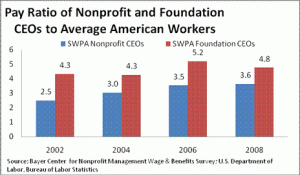Upon joining the non-profit sector, a number of people opined to me that they are happy I’ve decided to dedicate my time and effort towards strengthening the sector’s work. In fact, one of the sound bites I kept hearing is that non-profits – despite their inability to sell equity (and thus raise money through either private investors or the larger public capital market) or the lack of an agreed upon “profit” metric for measuring organizational success – need to behave more like for-profit businesses. So, listen up my fellow non-profit professionals, I’m going to impart some words of wisdom I learned from my days working in the for-profit world (at institutions such as Freddie Mac, UBS Investment Bank, and others).
We need larger pay packages to attract and retain qualified professionals. In order to create the type of fast thinking, innovative companies such as AIG, Bear Stearns, Enron, Tyco and others, we need to increase our compensation packages. Currently, this kind of fast-thinking/innovative executive talent retails for approximately $10.5 million, or roughly 344 times the average worker’s salary ($30,700). Since the average executive director of Southwestern Pennsylvania only makes a mere $96,110, or 3.6 times the average worker’s salary – that’s a lot of innovation we’re leaving on the table! Lesson #1: if we are to attract for-profit executive talent then we must start paying our non-profit executive directors better.


Ignore sustainability and adopt a “do whatever it takes” attitude to exceed your short-term goals. We in the nonprofit sector spend far too much time talking about creating sustainable programs and achieving long-term outcomes. Instead, we need to adopt a more market-centric view of the world, just as for-profit businesses have to when their performance is measured by the market. Take General Motors, for instance. In the late 1990s and well into the first decade of the 21st Century, GM ignored suggestions that the company should rethink its focus on the sale of light trucks and SUVs and instead become a pioneer in the production of fuel-efficient (sustainable) automobiles. However, GM’s short-term focus on becoming the premier seller of light trucks and SUV (its most profitable product line) seemed to be paying off:
In 2002, GM sold more than 8.5 million cars and trucks and was the first auto manufacturer to sell 1.2 million SUVs and 2.7 million trucks in a calendar year. The company set industry sales records in the United States and owned nearly 15 percent of the global vehicle market. And investors took notice – the company’s stock rose approximately 45% over the next year.
Of course, you know the rest of the story by now – fuel prices rose and consumers grew tired of paying for non-fuel efficient vehicles. GM was stuck with a bunch of cars and trucks (mostly trucks) that they tried to “give away” with 0% financing and large rebates – again, focusing on exceeding the company’s short-term sales numbers even at the expense of hurting long-term profit margins – but nobody wanted them. Lesson #2: for-profits rarely practice sustainable planning so why should your organization.

The market rewarded GM's banner 2002 year with stellar market returns in '03. Nevertheless, GM's lack of a sustainable business model finally forced the company into bankruptcy in '09.
Transform your board. Nonprofit executive directors, not only are you egregiously underpaid relative to your for-profit brethren, but also you need to hold more board power. This year’s Nobel Memorial Prize in Economics winner, Oliver Williamson, in a recent article, “Corporate Boards of Directors: In Principle and in Practice,” submits that today’s corporate boards are largely ruled by the CEO and are passive financial stewards. He writes:
The CEO is in de facto control of the operation and composition of the board…most boards most of the time are responding with nodding approval, and boards are beset by inertia, hence are slow to become active when the corporation experiences adversity” (260).
In hindsight, we’ve spent far too much time espousing the idea that nonprofit boards need to be active and chart the agency’s strategy, raise money, etc. After all, when is the last time you heard of a corporate board functioning this way? No, on a corporate board the CEO/Chairperson sets the agenda and the remaining board members are asked to “nod in approval.” Lesson #3: we need to retrain our board members to be passive financial stewards and centralize all power with the executive director (and newly appointed chairperson).
As you read these “lessons,” I hope it is apparent by now that there is an awful lot each sector – the for-profit and non-profit – can stand to learn from one another. I think the three lessons above illustrate areas the for-profit sector should take a cue from the nonprofit sector and consider adopting these practices. Conversely, there are a number of for-profit practices – strategic planning, capital budgeting, using data to inform evaluative programmatic judgments and more – that I believe are beneficial for nonprofits to adopt. However, to think that either sector has a monopoly on best practices is just over simplistic and flawed logic. As Jim Collins’ writes in his monograph Good to Great and the Social Sectors, “We need to reject the naïve imposition of the ‘language of business’ on the social sectors, and instead jointly embrace a language of greatness” (2). Touché, Jim.

 It’s about the radical changes in this brave new world we’re inhabiting when it comes to things like communications, organizing, publication…
It’s about the radical changes in this brave new world we’re inhabiting when it comes to things like communications, organizing, publication… Don’t underestimate this, and don’t forget it. If you want your nonprofit to be meaningful in the future, Web 2.0 is one bandwagon (remember those? – I don’t!) you’d better figure out how to get on.
Don’t underestimate this, and don’t forget it. If you want your nonprofit to be meaningful in the future, Web 2.0 is one bandwagon (remember those? – I don’t!) you’d better figure out how to get on.

 In the mid-90s, when I was still doing my undergraduate work, my Research class professor told us “at any given time, you have three resources available to you: time, money, or energy. When you are working on a project, you have to figure out what you have the most of and use it to your advantage.”
In the mid-90s, when I was still doing my undergraduate work, my Research class professor told us “at any given time, you have three resources available to you: time, money, or energy. When you are working on a project, you have to figure out what you have the most of and use it to your advantage.” self-sufficient.
self-sufficient.
